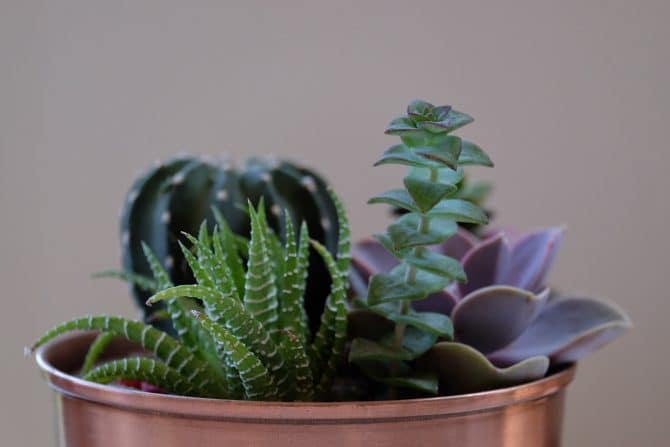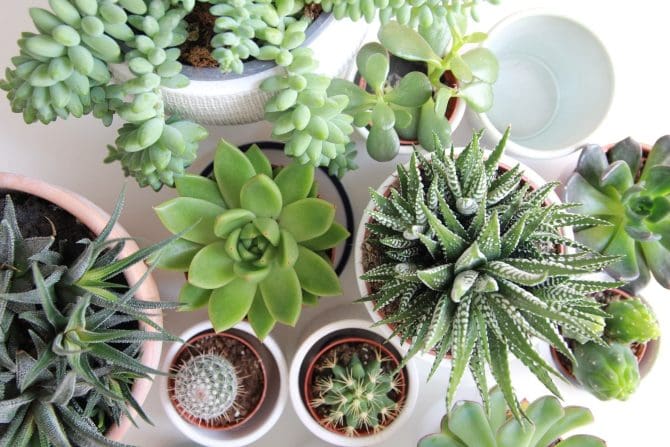Looking to add some life to your desk or study space? Consider using a house plant for a pop of color and fresh air in your room. If you've never cared for a plant before, try starting with a succulent. Our tips will help your new plants thrive and turn your thumbs green.
What is a succulent?
So glad you asked! A succulent, in botanical terms, is any plant that has thick, fleshy tissues and can store a lot of water as an adaptation for arid climates or soil conditions.
These tissues can be in the leaves, such as in aloe vera or the jade plant (crassula ovata) or in the stems, like many cacti.
They aren’t all related, so it’s not a scientific classification term, but it is a good descriptive term. While the plants may not be related, there are enough things in common to make them useful for people who want to grow low-maintenance houseplants.
How do I take care of a succulent plant?
It’s typically very easy. The main thing to know is that all succulent plants, no matter where they come from or how they evolved, are all adapted to dry conditions; usually where there is a lot of rain all at once, but infrequently, such as a desert. The purpose of the tissues is to store a lot of water when it is available to save for use when it is not. Many, though not all, succulent plants also use something called “crassulacean acid metabolism” (CAM), a biochemical process that allows the plant to avoid losing water during photosynthesis in the way most plants do. It’s also fun to say.
In summary, they do not need much water. In fact, overwatering is the most common mistake a succulent keeper can make. Once a week is generally safe, but if you are concerned, you can look up the exact species of plant for a more specific recommended schedule. Succulent plants should also be kept in soil that drains easily, and in pots or planters with drainage holes. Soak the soil directly when you do water the plant, then let it dry completely before the next watering.
Standard potting soil or dirt from your yard will not do. Mix in plenty of pearlite or get a specialized potting mix designed for cacti or specific type of succulent to ensure proper drainage. Cactus potting soil is easy to find—any stores that sell gardening supplies will have it.
Your succulent will also all need plenty of bright sunlight or equivalent artificial light, typically for at least six hours a day. Plants that use CAM will also require at least as much time in near total darkness every 24 hours—they only absorb CO2 from the air in the dark, which is the main way CAM helps them save water in dry climates. Be sure to rotate the plant, so it gets light on all sides as well.
Like all plants, succulents need nutrients in the soil to grow and stay healthy, but many fertilizers will be far too concentrated which can “burn” the fragile roots. There are commercial succulent fertilizer products, which will be labeled and marketed as such, or you can try diluting a water-soluble plant food or using compost tea if you really know what you’re doing. Generally speaking, indoor succulent plants should only be “fed” once a year in the spring, or in the fall if they primarily grow during winter months.
What if my succulent plant gets sick?
Insects and other pests generally aren’t a problem, but can become attracted to and then damage the fragile roots of succulent plants if they are overwatered or overfertilized. Plant diseases that affect succulents are rare in Michigan, but they could be spread to a new plant while it is in a greenhouse with other plants. Infested or infected plants should be isolated, and if possible, cleaned with a 70% solution of isopropyl alcohol.
More commonly, a succulent may be looking sickly if it doesn’t get enough sunlight, or if it gets too much water or fertilizer, so in most cases you should be safe with minimal effort.
One unique concern for succulent plants is dust, which can accumulate on their stems or leaves and reduce the amount of light they can absorb. Use a soft damp cloth, or a paintbrush for our spikier friends, to keep your succulent plants clean and happy. Frequency will depend on how quickly the dust builds up where your plant lives.
Anything else I should know?
In case it wasn’t clear, succulent plants tend to come from warmer areas of the Earth. While they aren’t all from really hot deserts, none of them are frost tolerant, or even fall hardy, and shouldn’t be kept outside if the temperature is going to drop below 50 degrees Fahrenheit.
However, they will enjoy the summer sun even here in Michigan, so feel free to bring them outside during the day when it’s warm out if you'd like. Just be careful of rainy days.




Add a comment to: Turn Your Brown Thumb Green With Succulents